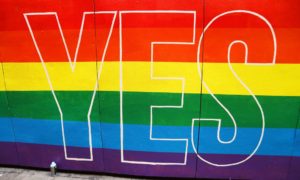Same sex marriage vote embraced
 Victorians led the charge towards the legalisation of same sex marriage, according to data from the Australian Bureau of Statistics (ABS).
Victorians led the charge towards the legalisation of same sex marriage, according to data from the Australian Bureau of Statistics (ABS).
Almost 65 per cent of Victorians backed the change – above the national figure of 62 percent and the highest of any state and second only to the ACT which accounted for less than 250,000 responses.
And Victoria saw the highest response rate with 82 per cent of eligible people responding.
All states and territories recorded a majority ‘Yes’ response. A massive 133 of the 150 Federal Electoral Divisions recorded a majority Yes response, and 17 of the 150 Federal Electoral Divisions recorded a majority ‘No’ response – just three of them were in Victoria.
Just over 79 per cent or 12,727,920 eligible Australians participated in the Australian Marriage Law Postal Survey, according to the ABS.
Females were more likely to participate than males. Nationally, 81.6% (6,644,192) of eligible females and 77.3 per cent (5,980,168) of eligible males participated in the survey.
Those aged 70 to 74 were the most likely to respond to the survey, with 89.6 per cent of eligible Australians in this age group participating.
The participation rate was lowest in those aged 25 to 29 at 71.9 per cent. The youngest age group of eligible Australians (those aged 18-19 years) were more likely (78.2 per cent) to participate than any other age group under the age of 45 years.
AMES Australia CEO Cath Scarth welcomed the result of the postal poll, saying it would particularly give heart to LGBTI people in culturally and linguistically diverse (CALD) communities.
“The result will give heart to LGBTI people in CALD communities who can face extra barriers and cultural difficulties in living in same sex relationships,” Ms Scarth said.
“We know that it can be difficult for people in some circumstances to ‘come out’ because of their cultural background,” she said.
“We hope the result of the postal poll sends a message that Australia is a tolerant, welcoming society where diversity is embraced,” Ms Scarth said.
Some reports about the poll point to high levels on ‘No’ votes in areas where there are large non-Anglo Celtic populations giving rise to the assertion that Australia’s multicultural communities, and particularly those of the Muslim faith, do not support same sex marriage.
But Executive Director of the Islamic Council of Victoria Nai, Aykan says there is a “misconception that the Muslim community is homogenous and that they all voted ‘No’.
“There is a good proportion, around 40 per cent that voted ‘Yes’, and from anecdotal evidence, overwhelmingly young Muslim women voted ‘Yes’,” Mr Aykan said.
“I don’t know why there is a focus on the Muslim community because we do not have that much influence,” he said.
Mr Aykan pointed out there was little information in social or traditional ethnic media from the ‘Yes’ campaigners.
Mr Aykan says that not all the 600,000 Muslims in Australia voted ‘No’, but those who did, like the Christians who voted ‘No’, may not be homophobic, they may just not feel that the marriage act should change.
Muslims are only 2.6 per cent of the population; a small percentage of the overall electorate and an even smaller proportion of the Australian electorate which voted ‘No’
“If you breakdown it down, one per cent of the 2.6 per cent voted ‘Yes’,” Mr Aykan said.
He says that it was significant that Muslim leadership was not vocal in either the ‘Yes’ or ‘No’ campaigns.
Professor of Sociology at the University of Technology Sydney Andrew Jakubowicz points out that the successful anti-Safe Schools campaign by the ‘No’ coalition particularly targeted communities with traditional cultural and religious morals.
He said many Australians from immigrant backgrounds who have low English language skills are very different to European professional immigrants who have arrived more recently.
Prof Jakubowicz wrote in ‘The Conversation’ that “in localities where there are strong communities built around Eastern Orthodoxy, Islam, Eastern Catholicism, African Christianities, Asian Christianities (from Catholic to Evangelical), and even in other areas with pockets of Orthodox Judaism, there were singular funnels of information presented in cultural and moral terms”.
Laurie Nowell
AMES Australia Senior Journalist












